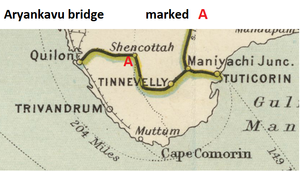Aryankavu Bridge
The Aryankavu bridge opened in 1904 and carried the ‘Shencottah-Quilon Section’ of the ‘Tinnevelly-Quilon Railway’ over the Aryankavu River; this was a metre gauge(MG) line operated as part of the ‘South Indian Railway’(SIR).

Spelling Notes
- Tinnevelly has modern spelling Tirunelveli
- Shencottah , also Sengottai has modern spelling Shenkottai
- Quilon has modern spelling Kollam
Various descriptions of this railway have been used in different records
- Kollam-Sengottai Railway
- Quilon-Shencottah Railway
The line was built jointly by the SIR, Travancore State and the Madras Presidency. The line, often called the 'Travancore Railway, was divided into two sections: -
- ‘Tinnevelly-Quilon (Travancore) Railway - British Section’ from Tinnevelly to the British Frontier near Shencottah, 50½ miles(81km)
- ‘Tinnevelly-Quilon (Travancore) Railway - Native State Section’ Frontier of the Travancore State to Quillon, 78 miles(126km)
Aryankavu bridge
After a survey in 1888, work started in 1900 and was completed by 1902. The first goods train travelled on this route in 1902 while the first passenger train began its run in 1904. Metre gauge services were inaugurated on 1 July 1904 with the first passenger train flagged off from Kollam by Maharajah Moolam Thirunal of Travancore with a 21-gun salute [1].
Wikimedia gives an image of the bridge and reports “The 13-arch Aryankavu bridge, nearly 110 years old, at Kazhathuruthi, near Punalur, Kerala, on the Kollam-Sengottai branch line that meanders through thick jungles and hills, is one of the prettiest in India [2].
Further Information
See Tinnevelly-Quilon Railway
and South Indian Railway – Metre Gauge – Travancore Railway
References
- ↑ Wikipedia ‘Kollam-Sengottai Branch Line’; Retrieved 13 Dec 2020
- ↑ Redff.com ‘The ancient heritage behond our railway bridges’ by Bibek Debroy. IMAGE 5: Aryankavu bridge; Retrieved 13 Dec 2020